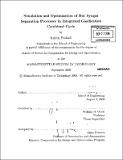| dc.contributor.advisor | William H. Green. | en_US |
| dc.contributor.author | Prakash, Kshitij | en_US |
| dc.contributor.other | Massachusetts Institute of Technology. Computation for Design and Optimization Program. | en_US |
| dc.date.accessioned | 2010-05-25T20:39:09Z | |
| dc.date.available | 2010-05-25T20:39:09Z | |
| dc.date.copyright | 2009 | en_US |
| dc.date.issued | 2009 | en_US |
| dc.identifier.uri | http://hdl.handle.net/1721.1/55078 | |
| dc.description | Thesis (S.M.)--Massachusetts Institute of Technology, Computation for Design and Optimization Program, 2009. | en_US |
| dc.description | Cataloged from PDF version of thesis. | en_US |
| dc.description | Includes bibliographical references (p. 131-137). | en_US |
| dc.description.abstract | IGCC with CO2 capture offers an exciting approach for cleanly using abundant coal reserves of the world to generate electricity. The present state-of-the-art synthesis gas (syngas) cleanup technologies in IGCC involve cooling the syngas from gasifier to room temperature or lower for removing Sulfur, Carbon dioxide and Mercury, leading to a large efficiency loss. It is therefore important to develop processes that remove these impurities from syngas at an optimally high temperature in order to maximize the energy efficiency of an IGCC plant. The high temperature advanced syngas cleanup technologies are presently at various stages of development and it is still not clear which technology and configuration of IGCC process would be most energetically efficient. In this thesis, I present a framework to assess the suitability of various candidate syngas cleanup technologies by developing computational simulations of these processes which are used in conjunction with Aspen Plus® to design various IGCC flowsheet configurations. In particular, we evaluate the use of membranes and sorbents for CO2 separation and capture from hot syngas in IGCC, as a substitute to solutionbased absorption processes. We present a multi-stage model for CO2 separation from multi-component gas mixtures using polymeric membranes based on the solutiondiffusion transport mechanism. A numerical simulation of H2 separation from syngas using Pd-alloy based composite metallic membranes is implemented to assess their performance for CO2 sequestration. | en_US |
| dc.description.abstract | (cont.) In addition, we develop an equilibrium-based combined pressure and temperature swing adsorption-desorption model to estimate the amount of energy required for capturing pollutants using regenerable sorbent beds. We use our models with Aspen Plus® simulations to identify optimum design and operating conditions for membrane and adsorption processes in an IGCC plant. Furthermore, we identify from our simulations desired thermodynamic properties of sorbents and material properties of membranes that are needed to make these technologies work successfully at IGCC conditions. This should serve to provide an appropriate direction and target for ongoing experimental efforts in developing these novel materials. | en_US |
| dc.description.statementofresponsibility | by Kshitij Prakash. | en_US |
| dc.format.extent | 137 p. | en_US |
| dc.language.iso | eng | en_US |
| dc.publisher | Massachusetts Institute of Technology | en_US |
| dc.rights | M.I.T. theses are protected by
copyright. They may be viewed from this source for any purpose, but
reproduction or distribution in any format is prohibited without written
permission. See provided URL for inquiries about permission. | en_US |
| dc.rights.uri | http://dspace.mit.edu/handle/1721.1/7582 | en_US |
| dc.subject | Computation for Design and Optimization Program. | en_US |
| dc.title | Simulation and optimization of hot syngas separation processes in integrated gasification combined cycle | en_US |
| dc.type | Thesis | en_US |
| dc.description.degree | S.M. | en_US |
| dc.contributor.department | Massachusetts Institute of Technology. Computation for Design and Optimization Program | |
| dc.identifier.oclc | 587445817 | en_US |
